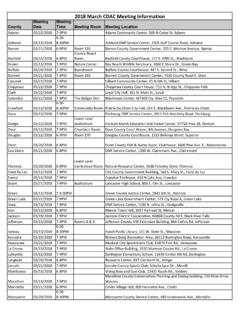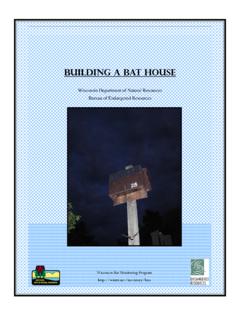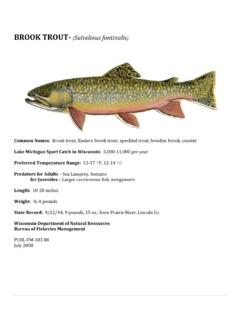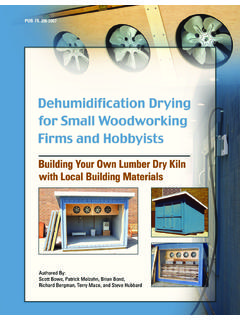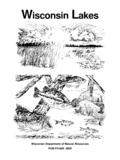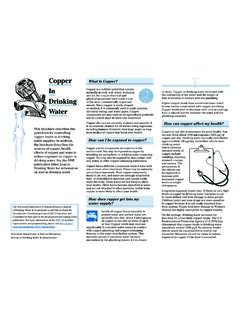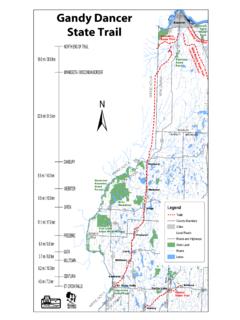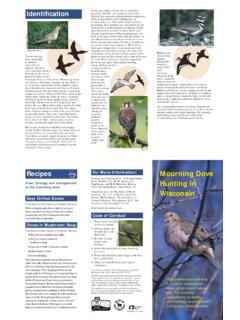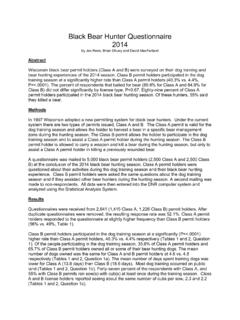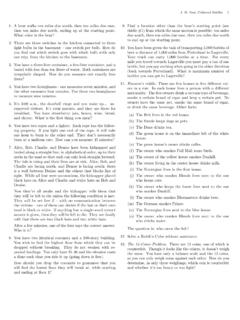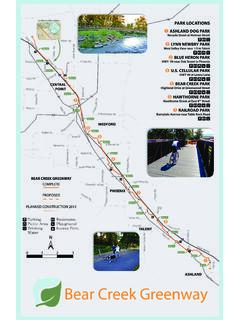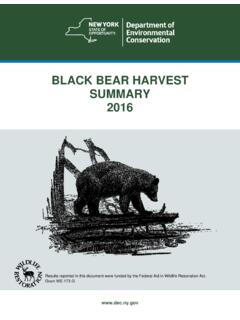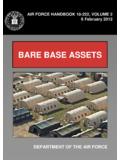Transcription of Advanced Activated Sludge Study Guide
1 Printed on 12/11/12 Advanced Activated Sludge Study GuideSubclass CWisconsin Department of Natural ResourcesBureau of Science Services, Operator Certification Box 7921, Madison, WI 53707 2010 EditionWisconsin Department of Natural ResourcesThe Wisconsin Department of Natural Resources provides equal opportunity in its employment, programs, services, and functions under an Affirmative Action Plan. If you have any questions, please write to Equal Opportunity Office, Department of Interior, Washington, 20240. This pub lication is availab le in alternative format (large print, Braille, audio tape. etc.) upon request. Please call (608) 266-0531 for more Operator CertificationPrinted on 12/11/12 PrefaceThis operator's Study Guide represents the results of an ambitious program. Operators of wastewater facilities, regulators, educators and local officials, jointly prepared the objectives and exam questions for this to use this Study Guide with referencesIn preparation for the exams you should:1.
2 Read all of the key knowledge s for each Use the resources listed at the end of the Study Guide for additional Review all key knowledge s until you fully understand them and know them by is advisable that the operator take classroom or online training in this process before attemptingthe certification A Test DateBefore you choose a test date, consider the training opportunities available in your area. A listing of training opportunities and exam dates is available on the internet at , keyword search "operator certification". It can also be found in the annual DNR "Certified Operator" or by contacting your DNR regional operator certification Study Guide is the result of the efforts of the following workgroup individuals:Chris Marx, Chilton WWTPMatt Schmidt, Green Bay MetroJoe Flanagan, Blanchardville WWTPGary Hanson, AEComDoug Nelson, Ruekert & MielkeJim Shaw, ITT SanitaireDan Tomaro, Wastewater Training SolutionsCurtis Nickels, WIDNR-PlymouthHannah Fass, WIDNR-MadisonAmy Schmidt, WIDNR-MadisonJack Saltes, WIDNR-MadisonAdvanced Activated Sludge Study Guide - Decemb er 2010 EditionPrinted on 12/11/12 Chapter 1 - Theory and PrinciplesChapter 2 - Operation and MaintenanceChapter 3 - Monitoring, Process Control.
3 And TroubleshootingChapter 4 - Safety and RegulationsChapter 5 - CalculationsSection - DefinitionsSection - Microbiological PrinciplesSection - Process VariationsSection - DefinitionsSection - MethodsSection - EquipmentSection - DefinitionsSection - Sampling & TestingSection - Data Understanding & InterpretationSection - Side Streams/Recycle FlowsSection - Performance Limiting FactorsSection - Corrective ActionsSection - Personal SafetySection - RegulationsSection - Sludge Age CalculationsSection - Food to Microorganism Ratio CalculationsSection - Sludge Volume Index CalculationsSection - Wasting Rates CalculationsTable of ContentsAdvanced Activated Sludge Study Guide - Decemb er 2010 Editionpg. 1pg. 1pg. 4pg. 5pg. 8pg. 10pg. 12pg. 13pg. 17pg. 19pg. 19pg. 22pg. 22pg. 23pg. 23pg. 24pg. 24pg. 24 Printed on 12/11/12 Page 1 of 27 Chapter 1 - Theory and PrinciplesSection - DefinitionsSection - Microbiological PrinciplesFigure period of time that wastewater remains in a tank.
4 This is important because treatment processes require sufficient time for the wastewater to be principle role microorganisms have in the Activated Sludge process is to convert dissolved and particulate organic matter, measured as biochemical oxygen demand (BOD),into cell mass. In a conventional Activated Sludge process, microorganisms use oxygen to break down waste so it can be used as food for their growth and survival. Over time and as wastewater moves through the aeration basin, food (BOD) decreases as microorganisms utilize it in the presence of oxygen for growth and reproduction with a resultant increase in cell mass (MLSS concentration). This is known as the Growth Phase, where excess food (BOD) is available allowing for optimal bacterial cell growth with the uptake of oxygen. As food (BOD) is used and decreases, growth declines (Declining Growth Phase) and bacteriaeventually reach a level production. This is known as the Stationary Phase.
5 As the food (BOD) is used up and decreases over time to very low levels, microorganisms will then use stored food in their cells and slowly begin to die. Cell mass (MLSS) will decrease. This is known as the Endogenous an Activated Sludge system is first started up, the Activated Sludge is very young and thin, the organisms an operator would see under the microscope are ameoba and some flagellates. During the Growth Phase, as the mixed liquor suspended solids (MLSS) builds and Sludge age increases, flagellates and free swimmers will be seen. When the mixed liquor suspended solids and Sludge age reach an optimum level for treatment, flagellates decline, and free swimming ciliates and stalked ciliates will be seen in more abundance. Hydraulic Retention Time (HRT)Describe the growth curve in the Activated Sludge the relative abundance of Activated Sludge indicator organisms (protozoa and rotifers) relative to Sludge age an operator can expect to see under the Activated Sludge Study Guide - Decemb er 2010 EditionPrinted on 12/11/12 Page 2 of 27 Figure Sludge gets older, more stalked ciliates and rotifers will be commonly seen.
6 If the Sludge gets too old, rotifers and nematodes will dominate. By observing the relative abundance of these indicator organisms the operator will be able to quickly tell the age and health of his Activated Sludge . The protozoan species that are most dominant indicate the environmental conditions occuring in the process, especially therelative age of the Sludge . Sludge age is controlled by wasting, the operator can adjust the wasting rate to influence the microbiological population and health of the Activated Sludge system and resultant effluent protozoan count procedure is used to determine the relative numbers of protozoa in the Activated Sludge treatment process. The protozoan species that dominate are very helpful in assessing the conditions of the Activated Sludge process. The count examines protozoa in the following categories:A. AmoebaB. FlagellatesC. Free-swimming ciliatesD. Crawling ciliatesE. Stalked ciliatesF.
7 Metazoa (rotifers, nematodes, water bear , etc.)See figure for an example count worksheet. The operator is referred to the references for Protozoan Count Activated Sludge Study Guide - Decemb er 2010 EditionPrinted on 12/11/12 Page 3 of 27 Figure total pounds of Sludge produced per pound of BOD removed can vary considerably depending on plant specific conditions. The amount of inert total suspended solids must behandled as well as the Sludge volatile (biological) matter produced in the process. Total Sludge production can reach 1 pound of total Sludge per pound of BOD removed, especially, in facilities without primary clarification or poor preliminary treatment. Sludge handling facilities must be sized to handle the total Sludge unit Sludge production values for various processes are shown in figure the Sludge production (in pounds of volatile matter per pound of BOD removed) in the Activated Sludge Activated Sludge Study Guide - Decemb er 2010 EditionPrinted on 12/11/12 Page 4 of 27 Section - Process VariationsFigure are single-celled microscopic organisms, several hundred times larger than bacteria.
8 It is the protozoa we observe under a microscope since bacteria are actually too small to see. There are four types of protozoa commonly found in Activated Sludge systems. They are identified by their method of movement within the wastewater environment. The four types are amoeba, ciliates (free-swimming and stalked), flagellates and suctoreans. Rotifers are multi-celled (metazoa) organisms also commonly found in Activated Sludge systems. The relative predominance of these protozoa is commonly associated with the age of the Activated the types of protozoa and organisms commonly found in Activated Sludge and observable under a Activated Sludge Study Guide - Decemb er 2010 EditionPrinted on 12/11/12 Page 5 of 27 Chapter 2 - Operation and MaintenanceSection - DefinitionsFigure plug flow Activated Sludge is a process in which influent and returned activatedsludge enters at the head of the aeration tank and travels through the tank at a constant rate to the point of discharge.
9 The Sludge age is generally less than 15 days, usually best between 3-10 aeration uses conventional plug flow patterns, however, the aeration tanks are larger to provide for over 15 hours of hydraulic retention times (HRT). The Sludge age is typically greater than 15 days, usually best between 15-30 days. This results in a highly treated effluent, and less WAS produced. The oxidation ditch is a variation of the extended aeration conventional (plug flow) Activated Sludge the extended aeration Activated Sludge variable frequency drive (VFD). Advanced Activated Sludge Study Guide - Decemb er 2010 EditionPrinted on 12/11/12 Page 6 of 27 Variable Frequency Drive (VFD) is a system for regulating the rotational speed of an alternating current (AC) electric motor by controlling the frequency of the electric power supplied to the transfer efficiency is measured by the exchange of oxygen between the gas that is absorbed in a liquid compared to the amount of gas fed into the liquid.
10 This is normally expressed as a oxygen transfer efficiency (OTE).Diagram full floor coverage, side roll, and center roll placement of Activated Sludge Study Guide - Decemb er 2010 EditionPrinted on 12/11/12 Page 7 of 27 Figure Activated Sludge Study Guide - Decemb er 2010 EditionPrinted on 12/11/12 Page 8 of 27 Section - MethodsFigure diffused aeration system consumes approximately half of the power consumed in a wastewater treatment plant. Equipment:A. Type of aeration system diffusers (ultra fine bubble, fine bubble, coarse bubble) B. Diffuser placement on the tank floor (full floor coverage, side placement or center placement)C. System operating pressure D. Oxygen transfer efficiency (following ASCE standard test) Operations:A. Diffuser maintenanceB. Mixed liquor suspended solids C. Excess process dissolved oxygen The most efficient aeration system is a combination of fine bubble and high oxygen transfer efficiency with the diffusers placed in full floor coverage with a mid-range system pressure the factors that most influence energy consumption in a diffused aeration Activated Sludge Study Guide - Decemb er 2010 EditionPrinted on 12/11/12 Page 9 of 27(6-8 psi) and annual cleaning.

